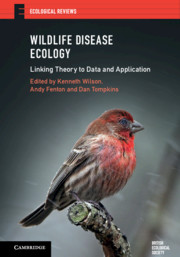Book contents
- Wildlife Disease Ecology
- Ecological Reviews
- Wildlife Disease Ecology
- Copyright page
- Contents
- Contributors
- Preface: Wildlife Disease Ecology
- Glossary of Terms
- Part I Understanding within-host processes
- Part II Understanding between-host processes
- Part III Understanding wildlife disease ecology at the community and landscape level
- Chapter Fifteen The ecological and evolutionary trajectory of oak powdery mildew in Europe
- Chapter Sixteen Healthy herds or predator spreaders? Insights from the plankton into how predators suppress and spread disease
- Chapter Seventeen Multi-trophic interactions and migration behaviour determine the ecology and evolution of parasite infection in monarch butterflies
- Chapter Eighteen When chytrid fungus invades: integrating theory and data to understand disease-induced amphibian declines
- Chapter Nineteen Ecology of a marine ectoparasite in farmed and wild salmon
- Chapter Twenty Mycoplasmal conjunctivitis in house finches: the study of an emerging disease
- Chapter Twenty-one Processes generating heterogeneities in infection and transmission in a parasite–rabbit system
- Chapter Twenty-two Sylvatic plague in Central Asia: a case study of abundance thresholds
- Index
- Plate Section (PDF Only)
- References
Chapter Twenty - Mycoplasmal conjunctivitis in house finches: the study of an emerging disease
from Part III - Understanding wildlife disease ecology at the community and landscape level
Published online by Cambridge University Press: 28 October 2019
- Wildlife Disease Ecology
- Ecological Reviews
- Wildlife Disease Ecology
- Copyright page
- Contents
- Contributors
- Preface: Wildlife Disease Ecology
- Glossary of Terms
- Part I Understanding within-host processes
- Part II Understanding between-host processes
- Part III Understanding wildlife disease ecology at the community and landscape level
- Chapter Fifteen The ecological and evolutionary trajectory of oak powdery mildew in Europe
- Chapter Sixteen Healthy herds or predator spreaders? Insights from the plankton into how predators suppress and spread disease
- Chapter Seventeen Multi-trophic interactions and migration behaviour determine the ecology and evolution of parasite infection in monarch butterflies
- Chapter Eighteen When chytrid fungus invades: integrating theory and data to understand disease-induced amphibian declines
- Chapter Nineteen Ecology of a marine ectoparasite in farmed and wild salmon
- Chapter Twenty Mycoplasmal conjunctivitis in house finches: the study of an emerging disease
- Chapter Twenty-one Processes generating heterogeneities in infection and transmission in a parasite–rabbit system
- Chapter Twenty-two Sylvatic plague in Central Asia: a case study of abundance thresholds
- Index
- Plate Section (PDF Only)
- References
Summary
Mycoplasma gallisepticum causes disease in poultry and emerged as a novel pathogen in house finches resulting in a mycoplasmal conjunctivitis epidemic across North America after a single successful host jump from poultry to house finches. The rapid spread of the epidemic across eastern North America, causing a decline in host abundance, has been documented. Once established, disease prevalence showed regular seasonal variation: a late summer/early autumn peak, a mid-December minimum, followed by a late winter peak and a breeding season minimum, which requires seasonal reproduction (providing an autumn pulse of naïve hosts) and winter social aggregation as well as partial immunity of recovered birds. Virulence evolved rapidly: in eastern populations it increased once the disease had become endemic. In western North America the established strain was of much lower virulence, but once established also increased in virulence. We show that virulence may evolve in opposite directions depending on selection pressures. A detailed study showed that disease decreased survival and mobility and a high proportion of birds recovered; also that re-observation rates of clinically diseased birds are often different from those of asymptomatic birds; only calculations which include this effect allow an accurate estimate of disease prevalence.
- Type
- Chapter
- Information
- Wildlife Disease EcologyLinking Theory to Data and Application, pp. 574 - 597Publisher: Cambridge University PressPrint publication year: 2019



